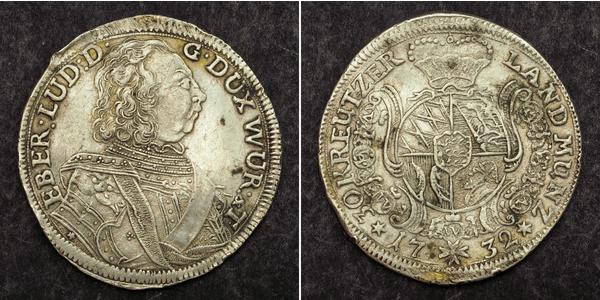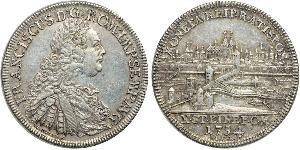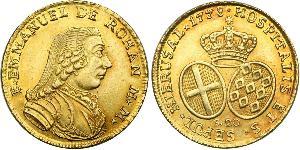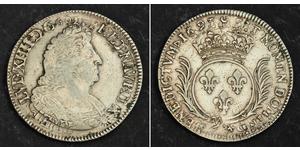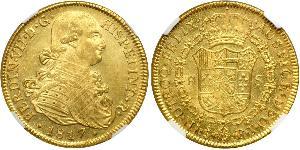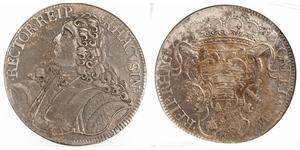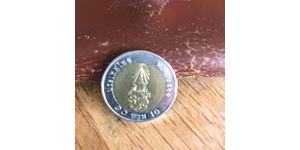(sold for $149.0)
Mint Year: 1732 Reference: KM-319 ($400 in XF!) Denomination: 30 Kreuzer (½ Gulden) Condition: Minor dark oxidation dposits, a few small scratches and edge bruses, otherwise XF-AU! Diameter: 30mm Weight: 7.08gm Material: Silver
Obverse: Armored bust of Duke Eberhard Louis right. Legend: EBER : LUD : D . - G . DUX WUR : & T.
Reverse: Crowned oval coat-of-arms within order chain. Date (17-32) split by cross order below. Value in legend around. Legend: 30 KREUTZER - LAND MUNZ * 17 + 32 *
The Duchy of Württemberg (German: Herzogtum Württemberg) was a duchy located in the south-western part of the Holy Roman Empire. It was a member of the Holy Roman Empire from 1495 to 1806. The dukedom's long survival for nearly four centuries was mainly due to its size, being larger than its immediate neighbors. During the Protestant Reformation, Württemberg faced great pressure from the Holy Roman Empire to remain a member. Württemberg resisted repeated French invasions in the 17th and 18th centuries. Württemberg was directly in the path of French and Austrian armies who were engaged in the long rivalry between the House of Bourbon and the House of Habsburg. In 1803, Napoleon raised the duchy to be the Electorate of Württemberg of the Holy Roman Empire. On 1 January 1806, the last Elector assumed the title of King of Württemberg. Later this year, on 6 August 1806, the last Emperor, Francis II, abolished (de facto) the Holy Roman Empire.
Duke Eberhard Louis (18 September 1676 – 31 October 1733) was the tenth duke of Württemberg, from 1692 until 1733.
Eberhard Louis was born in Stuttgart the third child of Duke William Louis and his wife, Magdalena Sibylla of Hesse-Darmstadt. After the early and unexpected death of his father in 1677, the royal court decided to give guardianship to his uncle, Frederick Charles, Duke of Württemberg-Winnental.
In 1693, Magdalena Sibylla had the 16-year-old Eberhard Louis prematurely proclaimed Duke of Württemberg by Emperor Leopold I. The young duke showed no excessive interest in governmental affairs. Eberhard Louis was described by his contemporaries as superficial and easily influenced. Most importantly, his behavior led to the political fate of the land being greatly decided by his council. The duke preferred hunting and left the administration of his county in the hands his advisors. In 1697, he married Joanna Elisabeth of Baden-Durlach.
In 1707 he became the field marshal of the Swabian troops in the War of the Spanish Succession.
Shortly before 1700, he visited Louis XIV of France at the Palace of Versailles and planned to make an absolutist state out of Württemberg. He raised taxes, but financing still remained an obstacle. In 1704, he laid the foundation for his Ludwigsburg Palace. To save money, he allowed the workers to reside tax-free around the palace for 15 years. Later, the city of Ludwigsburg developed out of these residences.
As of 1711, Eberhard Louis spent ever more time in Ludwigsburg, usually in the company of his mistress, Wilhelmine von Grävenitz, whom he married in 1707. Because of pressure from the emperor, the marriage had to be quickly dissolved, and Grävenitz went into exile. Eberhard Louis followed her to Switzerland, where they stayed until 1710. The influential mistress was only allowed to return to the royal court once she had married another man, Graf von Würben. For over two decades, Grävenitz had a strong influence on the government of the land, and it was she who, together with Eberhard Ludwig, moved the royal residence and capital of the duchy from Stuttgart to the sparsely populated city of Ludwigsburg. Duchess Joanna Elisabeth of Baden-Durlach stayed in the royal palace in Stuttgart.
Because of the early death of his heir, Prince Frederick Louis, in 1731, the power threatened to shift into Catholic hands, which was unthinkable for Protestant Württemberg. Thus Duke Eberhard Louis dissolved his relations with Wilhelmine von Grävenitz and hoped to receive an heir from his legitimate and long ignored wife, Joanna Elisabeth. However, as he died in Ludwigsburg of a stroke on October 31, 1733, he left no heir behind. The duchy then fell into the hands of his converted nephew, Charles Alexander, Duke of Württemberg of the bloodline Württemberg-Winnental, though only for a few years.
Only 1$ shipping for each additional coin purchased!

|
Posted by:
anonymous 2019-04-12 |
990 coins were uploaded from 2025-05-21 to 2025-05-28
One of them is:

